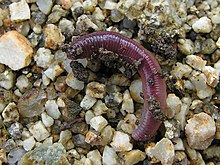Clitellata
| Clitellata Temporal range:
| |
|---|---|

| |
| Earthworm | |
| Scientific classification | |
| Domain: | Eukaryota |
| Kingdom: | Animalia |
| Phylum: | Annelida |
| Clade: | Pleistoannelida |
| Clade: | Sedentaria |
| Class: | Clitellata |
| Subclasses | |
|
Branchiobdellae Hirudinea " paraphyletic )and see text | |
The Clitellata are a
Characteristics
Clitellate annelids are segmented worms characterised by the clitellum or girdle which is located near the head end of mature individuals. The mouth is on the ventral surface and is overhung by the prostomium (proboscis). The brain is not located in the head but in one of the body segments. The clitellum is formed by a modification of several segments, and either includes the female gonopores or is located just behind them. During copulation, this glandular tissue secretes mucus that keeps the paired individuals together while they exchange sperm. Afterwards it secretes material that forms a cocoon that encircles the animal's body and encloses the eggs and sperm. The animal works this cocoon forward and over its head end, whereupon the ends of the cocoon become sealed, with fertilisation and development taking place inside.[2][3]
Earthworms and their kin, in the subclass Oligochaeta, lack eyes but have photoreceptor cells in the skin, especially in the dorsal portion of the anterior end. They also lack parapodia and appendages on the prostomium, the body and the periproct (terminal segment on which the anus is located). The gonads are located in a few segments near the clitellum, with the testes being anterior to the ovaries. There are four bundles of one to twenty-five chaetae on each segment; these have muscles attached to their bases and can be extended or retracted.[2]
Leeches, order Hirudinida,
Distribution and habitat
Clitellates live on land, in freshwater or in the ocean. The subclass
The subclass Oligochaeta, which includes the earthworms as the largest members of the group, mostly live on land, burrowing in damp soil. Smaller freshwater species burrow in mud or live among aquatic vegetation. The marine species are mostly tiny and live in the interstices between sand grains, from the intertidal zone to the deep sea.[2]
Reproduction
All clitellata are
Systematics
According to modern phylogenetic analyses, the Clitellata are considered to be a
The group is divided into the subclasses
Hirudinea is
- abolish Oligochaeta as traditionally delimited in favor of a number of smaller monophyletic lineages[10]
- treat Oligochaeta and Clitellata as synonymous while splitting up the traditional "oligochaetes" into monophyletic lineages.[10]
Footnotes
- .
- ^ ISBN 978-81-315-0104-7.)
{{cite book}}: CS1 maint: multiple names: authors list (link - ^ "Animal reproductive system: Mechanisms that aid in the union of gametes: Annelids and mollusks". Encyclopedia Britannica. Retrieved 25 October 2017.
- .
- ^ Reichardt (2006): pp.63, 67–68
- PMID 19660115.
- S2CID 4428998.
- PMID 24567512.
- .
- ^ a b c Erséus et al. (2008)
References
- Erséus, Christer; Wetzel, Mark J. & Gustavsson, Lena (2008): ICZN rules – a farewell to Tubificidae (Annelida, Clitellata). Zootaxa 1744: 66–68. PDF fulltext
- Reichardt, Anna Katharina (2006): Systematische Zoologie.
